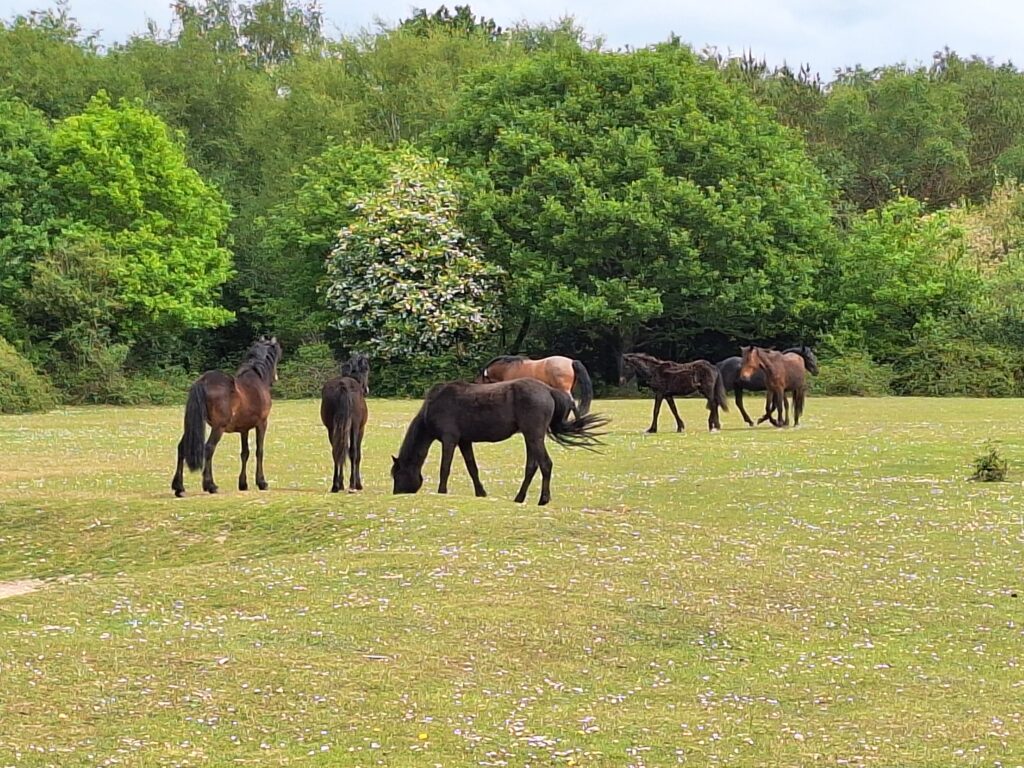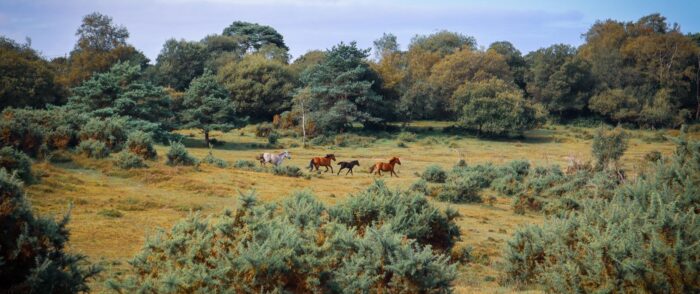How the New Forest Association helps to support commoning
This summary of the New Forest Association’s work was written by Sarah Nield, the organisation’s new chair. The report was first published in the New Forest CDA annual review for 2024/25.
The past year, like most others in recent times, has been a busy one for the NFA.
Coupled with the range of issues that impact on the Forest, the NFA has seen a changing of the guard with John Ward, our memorable chair for the past decade, standing down and Sarah Nield moving from being secretary to becoming chair.
A change at the top often offers an opportunity to look at the management of an organisation and the NFA has been looking at its business strategy and profile.
It’s not that our core mission has changed or we want to do anything differently, it is rather that we would like to increase our profile and membership to make sure people know and hopefully support what we do.
The first step in that process has been to revert to our registered name and logo. Some CDA members, I suspect, may have always referred to us as the NFA.
We have always supported commoning and several of our projects this year have looked to commoning. For instance, Jo Ivey has been looking at the availability of back-up grazing. This is important research given that the planning authorities tell us that they find it difficult to consider the need for back-up grazing in their planning decisions given the lack of data.
We also take a keen interest in present debates over the changing financial support structure for commoning and are keenly aware that the financing of the Forest, as a whole, rests on shaky foundations that need to be stabilised.
Most of the work of the NFA is carried out by our expert committees – Planning and Transport (PTC), and Habitats and Landscape (HAL). As part of our renewed strategy, we have revived two additional committees – the Recreation Committee (RC) and the Membership and Marketing Committee (MMC).
That said our consultative council, with your chair often in attendance, continues to be a most important forum for the discussion of Forest matters. His contribution has been and continues to be invaluable, and we welcome the close working relationship between our two organisations.
HAL has concentrated on issues where it believes a difference can be made. Thus, most of its work is longer term and strategic although it is always ready to address topics of immediate concern. Questioning the adequacy of Forestry England’s environmental assessments for the food vans in certain Forest car parks being just one example.
The introduction of beavers throughout Britain is an issue that HAL has considered this year. In many cases, beavers bring benefits particularly to flood prevention.
However, the Forest is somewhat different. It already has the habitats associated with beavers and thus HAL has been working with beaver experts to identify the Forest context and what is needed to identify and manage the risks to Forest habitats including Forest grazing.
It is gratifying to see that HAL’s work, funded by the NFA, into the water quality of Forest rivers and wetlands is bearing fruit with continuing research, monitoring and lobbying now continuing with a range of partners.
The absence of an effective strategy for the management of recreation continues to give concern to the NFA. Over the past year, this became manifest in extensive, ad hoc proposals to extend the official cycle route network across the Forest.

Ponies in the New Forest
Unfortunately, the proposals were not informed by assessments of impacts on wildlife, commoning, aesthetics or the welfare of other users.
There is a problem with cycling on the Forest with our Byelaw Watches, the last conducted in the summer of 2024, showing continued widespread abuse and the lack of effective management. It is very difficult to contemplate yet more routes until those responsible demonstrate they will not just exacerbate existing problems.
The cycling debate has highlighted the fact that we still await full details of the promised spatial plans, with its associated thinking, for the allocation of recreational pressure both on the Forest and for its diversion to other green space in the vicinity. Outline proposals have been around for some time and 2025 is set as the year for their formal unveiling. In the meantime, rumours swirl.
Dovetailing with the spatial plan are local authorities’ recreational mitigation policies and the revenue they raise from contributions paid by developers when planning permission is granted. PTC and RC have been looking at this complex area.
The funds raised are expected to finance the implementation of the spatial plan and meet the cost of more rangers to control recreation. We know that aspects of these policies are tantalisingly close to fruition. Unfortunately, what is not close to seeing the light of day are attractive recreational opportunities outside the Forest boundary.
We sit with representatives of the CDA on the Camping Liaison Group. Whilst we are pleased to see improvement to campsites’ management and steps to address commoners’ liability for injury caused by commoners’ stock, concerns remain. A growing number of campsites are in unfavourable condition and are recommended for closure, whether permanently or temporarily, yet frustratingly there are still no clear plans to do so.
The PTC continues to monitor all planning applications and to make representations or objections where appropriate. They also respond to local plans and to nationwide consultations. With a change of government, these are coming thick and fast. In particular, PTC responded to the National Planning Policy Framework and is already looking to respond to other national consultations.
In this task the resources of the Campaign for National Parks have proved very useful. Given the unique Forest context, we do not always see eye to eye and do not hesitate to say so when necessary.
The Waterside always seems to be a focus of our attention on planning matters and 2024 was no different with Exxon’s carbon capture proposals. These included the threat of a pipeline across the southern part of the Forest on its way to planned carbon storage capacity off the Needles. Fortunately, the proposals were dropped at a relatively early stage but not before a good deal of opposition had been mobilised.
The Freeport and the upgrading of the A326 continue to cause concern but the ambitious Fawley Waterside development on the old power station site has been dropped at least for the time being. We wait to see what might follow.
And finally, but not least, we are very pleased to be able to announce that Sue Westwood has joined our Council where her considerable experience of the Verderers Court and commoning issues is sure to prove invaluable.
Sarah Nield – Chair, New Forest Association

Members Login
 Latest Tweets
Latest Tweets
Follow us
@realnewforest 4h
Icilibus sam quas aut eriatem nume corepta auta conet officaborem quodi corepta auta conet officaborem quodi apernat ectlpa dolorpiaecus.
@realnewforest 4h
Icilibus sam quas aut eriatem nume corepta auta conet officaborem quodi corepta auta conet officaborem quodi apernat ectlpa dolorpiaecus.
@realnewforest 4h
Icilibus sam quas aut eriatem nume corepta auta conet officaborem quodi corepta auta conet officaborem quodi apernat ectlpa dolorpiaecus.
With thanks for support from




